Lung Cancer Journalism Awards 2015
The overall GLCC prize for Excellence in Lung Cancer Journalism in 2015 has been awarded to Sander de Hosson for his candid and moving article, ‘The Final Couplet’.
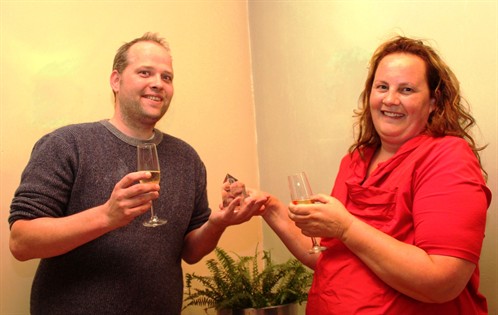
Sander de Hosson receives the Netherlands 2015 Global Lung Cancer Journalism Award from Monique van Orden of Lung Netherlands
Sander de Hosson is a doctor of pulmonology at the Wilhemina Ziekenhuis Hospital in Assen. He specialises in lung cancer and palliative care.
The GLCC panel members were particularly impressed by the unflinching honesty of this account of the final hours of a young lung cancer patient. The integrity and compassion of the piece reach the highest standards while reflecting the truth of what can be a challenging yet rewarding experience for all involved.
His article also won the Netherlands GLCC Journalism Award for 2015.
You can read the full article here:
The Final Couplet
by Sander de Hosson
Heart of summer. Early August. All of Holland is on holiday. We are sitting in the flesh-coloured morning light, in his back room, stuffed away behind the nurses’ station.
He is sick as hell and just 32. I am sitting next to his mother and his girlfriend. The intern and nurse are standing behind me, breathing carefully.
He sits with his back to us, at his table. Visibly fighting for air. Short of wind.
Hands covering his eyes. I notice his back bent. Track his breathing – 30 /35 tImes a minute. The window is open. The sweet smell of summer is wafting in. The contrast between the beauty of outside and the cruelty here inside takes me off-guard.
A few weeks ago I admitted that I liked him.
Probably not the most professional thing to say, but he clearly appreciated it. He had charisma. The kind of guy who lights up a boring party.
Death is always brutal, but the death of someone so young, at the peak of his life, is one of nature’s most heinous acts. That’s how I felt.
“Of course I’m bringing this home with me,” was my candid reply to one of the team residents.
He has an enormous tumour in his lungs that spread to his bones, liver and brain.
“My head?” he’d questioned hopelessly after I flipped over the MRI of his cerebrum.
The past few months, we had tried chemo after chemo. Called in renowned professors. The fear was always palpable. Dexamethasone. Pemetrexed. Etoposide. Erlotinib. Some other exotic names. All useless. The cancer continued to spread, mercilessly, gnawing away at his once notable physique, to leave this broken man sitting before us.
His breathing had become even more difficult the last weeks. He could no longer lie down because it made him feel like he was suffocating. That was because it had spread into the anterior chamber of his heart, cruelly assuring that any decent way of pumping his blood forward was impossible.
Decent. A word absent from cancer’s vocabulary.
The diagnosis was chilling. Pericarditis carcinomatosa. Latin for gruesome.
He had spent the last two days resting against his table. And that was where he sat, 24 hours a day. He slept with his head on that table. When I told him that I found it a rather humiliating option he snapped: “I will stay by my girlfriend until the very end. In full consciousness”.
Time and again, he’d turned down morphine, even though I had made it clear that it would not make him drowsy. He’d reply with stoic silence. Regardless of how ridiculous his refusal to take the morphine was to me, I truly admired his character.
His girlfriend glanced over at me. Late 20s. Pretty. She squeezed his hand. Her face, devastated.
And then she asked the question that had initially brought us here: “Can we still get married?”
We’d just taken several minutes to talk about The End. His very imminent death. “So, the final couplet has resounded,” he restated. Symbolically. Painfully. He frankly admitted his time was up. Finally. Death had already begun. He was looking despondent. He had known it for a while now. I shifted my gaze to the tag around his arm. We shared the same year of birth. I knew this. 1977.
“We can hold your wedding here, of course,” I said, “but then we have to hurry up a bit. Actually, we have to move pretty quickly. Today. Not a day later”.
In reality, I had no darn clue if it was even possible.
So there we stood. In the hall, the intern directly dials city hall in the neighbouring town.
We get the register office on the line and I brace myself for a bunch of bureaucratic nonsense and the kind of questions only God knows the answer to.
But what happens next is completely different. After telling the whole story, suddenly all the doors seem to be open. The mayor is pulled out of an important council meeting to sign the necessary papers. An army of civil servants is suddenly available to every beck and call. “Passport missing?” says the woman at the council, “who cares!” she adds in the same breath. Wow.
In no more than 50 minutes, we manage to arrange an entire wedding ceremony, from the witness to the officiant. This is not in my job description. But who cares? They can marry that afternoon.
In the meantime, half of the hospital’s support staff is pulling together to turn the sitting room into a virtual wedding chapel. Even the kitchen starts making a cake. I am astounded. This is care. This is what care is about.
The sun sets behind the trees in the distance. She is standing next to him in its soft rays. He, sitting, fighting for air. Intensely happy. They fold their hands together. This leaves an everlasting impression.
In the few short months since he became sick, they have reached a remarkable level of unity.
Full of strength and love, they say their wedding vows, swearing to be faithful till long, long after death has parted them. In the end, nothing remains but love.
The intern winks at me, teary-eyed. Together, we leave them. We cry. In the hallway. This, of course, is very unprofessional. I couldn’t give a damn.
He dies that very night. At his table. Next to his wife.
Copyright Sander de Hosson.
_______________________________________________________________________________________
New Jersey reporter wins US Print Journalism Award
From Carolyn Aldige, July 27 2016
A unanimous decision by all four US-based GLCC member organisations (CANCERcare, Prevent Cancer Fund, Lung Cancer America and Free to Breathe) see this year’s Print Journalism Award go to Lorraine Ash, a reporter for the Daily Record in Parsippany, New Jersey.
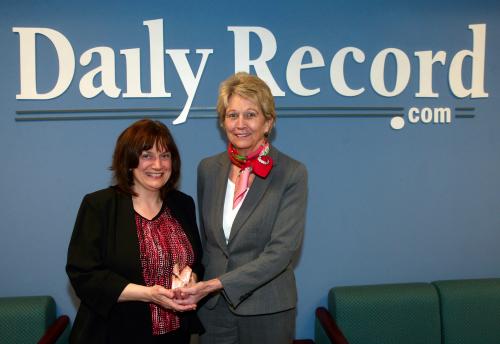
Lorraine Ash receives the award from Carolyn Aldige
Her article addressed several key issues, including stigma, the disparity between the number of deaths and the amount of research funding, and the availability of screening for high-risk individuals.
Using extensive interviews with lung cancer patient Rob Miscia and his wife, her article illustrated signicant aspects of the disease and its treatment.
Carolyn Aldige, President and Founder of the Prevent Cancer Foundation, said: “Lorraine tackled a difficult subject in an upbeat, informative and positive way. We are delighted to make this award to her”. You can read Lorraine’s article here:
In the US Broadcast section, special recognition awards have been made to Liza Meak, a broadcast journalist based in San Jose, California, and Molly Golbon, a young survivor of stage 4 lung cancer who never smoked.
Lisa and her partner David Burgess, a videographer, won the broadcast journalism award last year, but they expanded the piece they produced for the evening news into a full-length documentary, which received two Gracie awards.
[The Gracie Awards are presented by the Alliance for Women in Media Foundation (AWM). They are named after US radio and television star Gracie Allen.]
The documentary is called “Molly’s Journey: Living with Lung Cancer.”
It is a powerful piece of work, as Carolyn Aldige stated: “One of our judges said that on a scale of 1 to 10, she would give it a 25; the rest of us felt the same way, hence we are recognising both Liza, as producer, and Molly, as a lung cancer survivor, with these awards of special recognition”.
A third special recognition award goes to the videographer, David Burgess, who has since re-located to the Washington, DC area.
Victoria Herd wins UK Award for innovative social media campaign
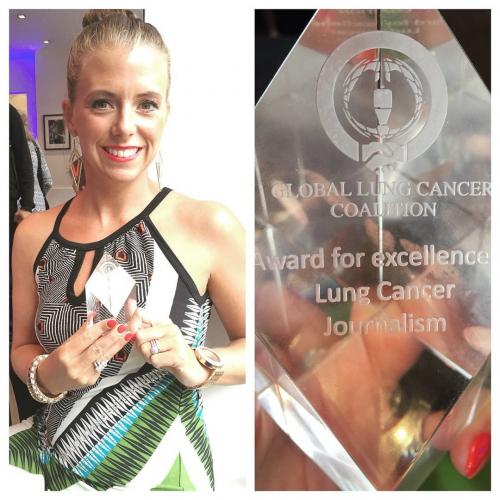
Victoria Herd is not a journalist in a conventional sense – yet she was nominated for the 2015 UK Excellence in Lung Cancer Journalism Award by Roy Castle Lung Cancer Foundation, the National Lung Cancer Forum for Nurses and the British Lung Foundation, in recognition of the impact of her unique social media awareness campaign.
The award also recognises her personal courage and dedication in setting up the campaign in memory of her mother, Janice Leverett, who died from lung cancer in March 2014.
Janice always ensured she faced the world armed with her trademark red lipstick – and it was this image that inspired Victoria to develop her campaign, the ‘Red Lipstick Selfie’.
Using social media, Victoria enabled her mother’s story, and the awareness message, to reach millions of people across the globe.
In presenting Victoria with the award, Paula Chadwick, Chief Executive of Roy Castle Lung Cancer Foundation, said: “Some may argue that this campaign is not journalism in its most traditional sense – but we say, on the contrary, Victoria has simply used the most modern and effective way of telling a very human story and getting an absolutely vital message out there to the world at large.
“That makes sense to us, and we are proud and delighted to make the award to Victoria, with our deepest gratitude and our warmest congratulations”.
Pulmonale makes 2015 journalism award to Carla Marina Mendes
Journalist Carla Marina Mendes has won recognition for the excellence of her work, with the 2015 Pulmonale Journalism Award.
The award was presented at a ceremony on 1st May.
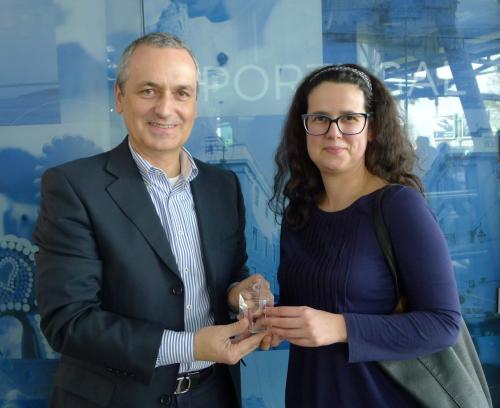
Here is an article written by Carla Marina, published in Destak, the first free daily newspaper in Portugal.

ESTUDO
Cancro do pulmão vai matar mais mulheres do que o da mama
27 | 01 | 2015 17.40H
Especialistas prevêem que taxa de morte do cancro do pulmão vai ultrapassar a da mama já durante este ano.
Carla Marina Mendes | cmendes@destak.pt
Tem sido, como mostram, ano após ano, as estatísticas, o cancro que mais mulheres mata. Mas o tumor maligno da mama pode ser destronado do primeiro lugar da lista dos mais mortíferos no feminino já este ano, confirma um estudo publicado hoje na revistaAnnals of Oncology. Na liderança, os especialistas colocam o cancro do pulmão.

Apesar de, asseguram os investigadores italianos e suíços, que se uniram para realizar o trabalho, o número anual de mortes por todos os tipos de cancro continue a crescer na União Europeia (UE), resultado do aumento do número de idosos, a taxa de mortalidade associada a esta doença vai, no geral, decrescer, com duas exceções: o cancro do pulmão nas mulheres e o do pâncreas em ambos os sexos.
«Precisamos de ter cautela com as taxas de mortalidade do cancro do pulmão nas mulheres, uma vez que isto são apenas previsões» alerta, em comunicado, Carlo La Vecchia, professor da Faculdade de Medicina da Universidade de Milão e um dos autores do estudo. «Os dados sobre o número real de mortes na UE, em 2015, apenas estará disponível daqui a três ou quatro anos. E é preciso ter cuidado porque os números absolutos de mortes para o cancro da mama continuarão mais elevados do que os do pulmão. No entanto, as previsões de 2015 confirmam as nossas projeções de longo prazo, feitas há dois anos, de que as taxas de mortalidade do cancro do pulmão iriam ultrapassar as da mama nas mulheres em 2015.»
O estudo prevê um total de 1,3 milhões de mortes por cancro nos 28 estados-membros da UE em 2015 (766.200 nos homens e 592.900 nas mulheres). No que diz respeito ao cancro do pulmão, as previsões de mortalidade ajustada para a idade nas mulheres revelam um aumento de 9% desde 2009, ficando nos 14.24 mortes por cada cem mil habitantes,. No caso do do cancro da mama, as taxas devem ficar nos 14.22 por igual número de habitantes, o que representa uma quebra de 10,2% desde 2009. No entanto, o número global de mortes continuará ligeiramente mais alto para o cancro da mama (90.800) do que para o do pulmão (87.
An English translation of that article:
STUDY
Lung cancer is set to kill more women than breast cancer
Published on 27.01.2015
Experts predict that the death rate for lung cancer will exceed that for breast cancer.
by Carla Marina Mendes | cmendes@destak.pt
Year on year, statistics show that most types of cancer kill more women than men. Top of the list is malignant breast tumour – but that is set to be ‘dethroned’ as the deadliest cancer for women, according to a study published today in the journal Annals of Oncology. Now, say the experts, lung cancer is about to become the number one killer.
According to the Italian and Swiss researchers who have teamed up to carry out the work, the annual number of deaths from all cancers continues to grow in the European Union (EU), due to the increasing number of elderly people. The rate of mortality associated with this disease will, in general, start to decrease with two exceptions: lung cancer in women and cancer of the pancreas in both sexes.
“We need to be cautious with lung cancer mortality rates in women, since these are only forecasts” said Carlo La Vecchia, a professor at the Faculty of Medicine, University of Milan, and an author of the study.
“Data on the actual number of deaths in the EU in 2015 will only be available in three or four years. And we must be careful, because the absolute numbers of deaths for breast cancer remain higher than for lung. However, forecasts for 2015 confirm our long-term projections, made two years ago, that lung cancer death rates would overtake breast cancer in women by the end of 2015.”
The study predicts a total of 1.3 million cancer deaths in the 28 EU member states in 2015 (766,200 in men and 592,900 in women). With respect to lung cancer, the mortality estimates adjusted for age in women showed an increase of 9% since 2009 – 14:24 deaths per hundred thousand.
In the case of breast cancer, the rates should be in 14:22 for the same number of inhabitants, representing a decrease of 10.2% since 2009. However, the overall number of deaths will remain slightly higher for breast cancer (90,800) than lung (87,500).
‘Equal Right to Life’ nominates Irina Kosoglotova for GLCC award
Irina Kosoglotova is a medical journalist, currently writing for medical publications, bulletins and web platforms.
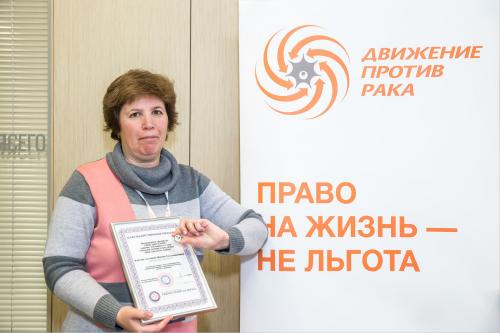
Her work covers a wide range of healthcare and public health provision topics. Irina’s main professional focus is on raising public awareness of issues affecting cancer patients.
Currently, she works for the “Equal Right to Life” bulletin, providing information to support cancer patients and their families.
Irina frequently covers the provision of adequate diagnostics for lung cancer, especially at regional level – always seeking to highlight positive examples.
She has been nominated for the 2015 GLCC Journalism Award as a result of several articles she has had published in the medical news platform medportal.ru.
One of these describes the case of a remote area of Russia, the Krasnoyarsk region, where an effective oncology service has been established, with a separate program for the early detection of lung cancer.
Irina also conducted excellent interviews with doctors and scientists – immuno morphologists – about methods of diagnostics and the potential for targeted therapy to treat lung cancer.
Television director Kazuo Hesegawa wins Cancer Net Japan GLCC journalism award 2015
Kazuo Hesegawa recently started a group called “One-Step” to support lung cancer patients by helping them to learn more about the disease, enabling them to make their own, better-informed, decisions on their treatment.
Mr Hesegawa, who has Stage IV lung cancer, is a television director and is currently making a documentary programme on his life with cancer.
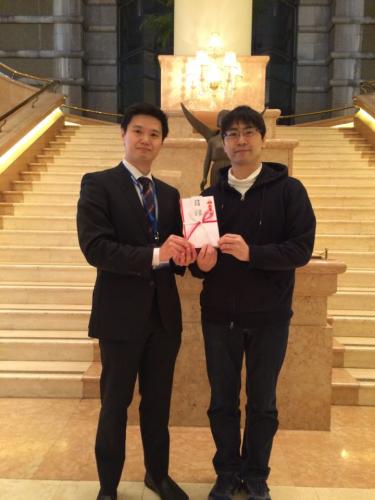
Kazuo Hasegawa receives the Cancer Net Japan 2015 Award for Journalism
Having initiated “One Step”, he now is trying to bring all the various lung cancer groups in Japan together.
Now, the first meeting of all the nation’s cancer patient support groups is set to take place on 28th November this year during the 56th annual meeting of the Japan Lung Cancer Society.
He and the Lung Cancer Association jointly submitted a request for early ratification of AZD 9291 to the Ministry of Health, and, as a result, the MoH has decided to list AZD9291 as a high priority medicine.
Cancer Net Japan made their 2015 Award for Excellence in Journalism is recognition of all the work Mr Hasegawa has done to raise awareness of the disease and to support people diagnosed with it.
Stödet makes 2015 GLCC Journalism Award to Susanne Hobohm
The Swedish Lung Cancer Advocacy (Stödet) has made its 2015 GLCC award for Excellence in Journalism to Susanne Hobohm, a former editor, editorial writer, columnist, teacher in journalism, producer and reporter.
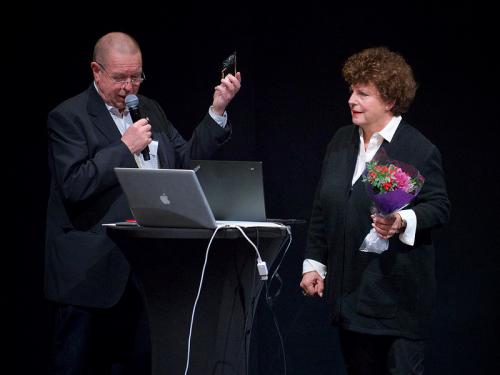
Tommy Björk of Stödet presents the award to Susanne Hobohm
Susanne was diagnosed with lung cancer after volunteering to donate a kidney to a relative in 2012. She is a non-smoker.
Following surgery, she is now fully active again and has worked extensively with television, newspapers and magazines in Sweden to raise awareness of lung cancer.
Catherine Halloran wins Irish Cancer Society GLCC Journalism Award
After some consideration and review of all media coverage on the issue during the 2015 Lung Cancer Awareness Month campaign, the Society decided to award the Irish Daily Star’s Catherine Halloran for her article on the 14th of January. The Irish Daily Star is a national tabloid with a circulation of 57,658. See their report here:http://thestar.ie/about-us/star-journalist-receives-award-for-cancer-story/
An official presentation was made to Catherine Halloran at our offices
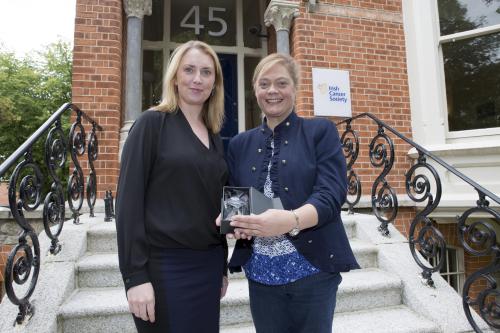
Aoife McNamara, Information Development Manager at the Irish Cancer Society presenting the GLCC’s Journalism Award to Catherine Halloran.
The ICS issued a media release around the award which was also covered in the Irish Daily Star.
The Netherlands Lung Cancer Journalism Award 2015
This year the Lung Cancer Journalism Award 2015 for the Netherlands was awarded to Sander de Hosson, a doctor of pulmonology at the Wilhemina Ziekenhuis Hospital in Assen. He specialises in lung cancer and palliative care.
You can read the full article below:
The Final Couplet
by Pulmonologist Sander de Hosson
Heart of summer. Early August. All of Holland is on holiday. We are sitting in the flesh-coloured morning light, in his back room, stuffed away behind the nurses’ station.
He is sick as hell and just 32. I am sitting next to his mother and his girlfriend. The intern and nurse are standing behind me, breathing carefully.
He sits with his back to us, at his table. Visibly fighting for air. Short of wind.
Hands covering his eyes. I notice his back bent. Track his breathing – 30 /35 tImes a minute. The window is open. The sweet smell of summer is wafting in. The contrast between the beauty of outside and the cruelty here inside takes me off-guard.
A few weeks ago I admitted that I liked him.
Probably not the most professional thing to say, but he clearly appreciated it. He had charisma. The kind of guy who lights up a boring party.
Death is always brutal, but the death of someone so young, at the peak of his life, is one of nature’s most heinous acts. That’s how I felt.
“Of course I’m bringing this home with me,” was my blatant reply to one of the team residents.
He has an enormous tumour in his lungs that spread to his bones, liver and brain.
“My head?” he’d questioned hopelessly, after I flipped over the MRI of his cerebrum.
The past few months, we had tried chemo after chemo. Called in renowned professors. The fear was always palpable. Dexamethason. Pemetrexed. Etoposide. Erlotinib. Some other exotic names. All useless. The cancer continued to spread, mercilessly, gnawing away at his once notable physique, to leave this broken man sitting before us.
His breathing had become even more difficult the last weeks. He could no longer lie down, because it made him feel like he was suffocating. That was because it had spread into the anterior chamber of his heart, cruelly assuring that any decent way of pumping his blood forward was impossible.
Decent. A word absent from cancer’s vocabulary.
The diagnosis as chilling. Pericarditis carcinomatosa. Latin for gruesome.
He had spent the last two days resting against his table. And that was where he sat, 24 hours a day. He slept with his head on that table. When I told him that I found it a rather humiliating option he snapped: “I will stay by my girlfriend until the very end. In full consciousness”.
Time and again, he’d turned down morphine, even though I had made it clear that it would not make him drowsy. He’d reply with stoic silence. Regardless of how ridiculous his refusal to take the morphine was to me, I truly admired his character.
His girlfriend glanced over at me. Late 20s. Pretty. She squeezed his hand. Her face, devastated.
And then she asked the question that had initially brought us here: “Can we, still? Get married?”
We’d just taken several minutes to talk about The End. His very imminent death. “So, the final couplet has resounded,” he restated. Symbolically. Painfully. He brazenly admitted his time was up. Finally. Death had already begun. He was looking despondent. He had known it for a while now. I shifted my gaze to the tag around his arm. We shared a birth year. I knew this. 1977.
“We can hold your wedding here, of course,” I said, “but then we have to hurry up a bit. Actually, we have to move pretty quickly. Today. Not a day later”.
In actuality, I had no darn clue if it as even possible.
So there we stood. In the hall, the intern directly dials city hall in the neighbouring town.
We get the register office on the line and I brace myself for a bunch of bureaucratic nonsense and the kind of questions only God knows the answer to.
But what happens next is completely different. After telling the whole story, suddenly all the doors seem to be open. The mayor is pulled out of an important council meeting to sign the necessary papers. An army of civil servants is suddenly available to every beck and call. “Passport missing?” says the council woman. “Who cares?” she adds in one breath. Wow.
In no more than 50 minutes, we manage to arrange an entire wedding ceremony, from the witness to the officiant. This is not in my job description. But who cares? They can marry that afternoon.
In the meantime, half of the hospital’s support staff is pulling together to turn the sitting room into a virtual wedding chapel. Even the kitchen starts making a cake. I am astounded. This is care. This is what care is about.
The sun sets behind the trees in the distance. She is standing next to him in its soft rays. He, sitting, fighting for air. Intensely happy. They fold their hands together. This leaves an everlasting impression.
In the few short months since he became sick, they have reached a remarkable level of unity.
Full of strength and love, they say their wedding vows, swearing to be faithful till long, long after death has parted them. In the end, nothing remains but love.
The intern winks at me, teary-eyed. Together, we leave them. We cry. In the hallway. This of course is very unprofessional. I couldn’t give a damn.
He dies that very night. At his table. Next to his wife.
Copyright Sander de Hosson.


